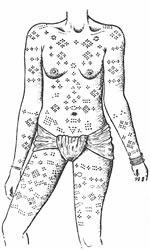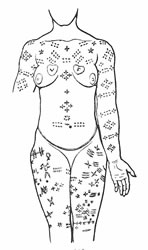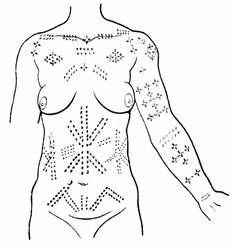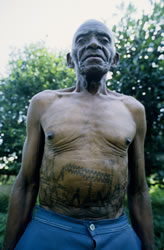Tattoos of Sub-Saharan Africa
Article © 2010 Lars Krutak
MOZAMBIQUE
Throughout Africa, body modification was a visual cue by which individuals could evaluate one another, especially if placed upon the face for all to see. When some Nhúngüé men of Mozambique were questioned about their characteristic facial markings in the 1940s and why they chose this location, they confirmed that is was an old custom. After war, they could easily identify the cadavers of their own tribe by their pigmented markings – they slit the throats of their enemies.
Some of the body markings of the Nhúngüé and the neighboring Chicunda were keloid in form, but the noted Portuguese physical anthropologist J.R. Dos Santos preferred to call them “tattoos in relief,” since a carbon pigment was added to the incisions. Any man or woman could be employed as the skin artist, although it is true that specialists existed and were sought after for their abilities. These individuals were known by the Nhúngüé as nhabézis or “doctors.”

|
|
 |
| Nhúngüé tattooing, 1940. |
|
Nhúngüé tattooing, 1940. |
The tools used to generate the tattoos were special lancets manufactured by the village blacksmith, but with increased contact with the outside world razors soon replaced the ancestral implements.
|
|
Nhúngüé and Chicunda women were profusely tattooed, on every region of the body. Aside from the common motifs, Dos Santos once saw two letters marking the inside of two hearts appearing on a Nhúngüé woman’s breasts. These letters corresponded to the initials of a white man that at one time lived with the woman.
In terms of the morphology of the traditional markings, they were composed of linear incisions, more or less punctured shapes distributed variably across the torso and thighs in cruciform, lozenge, and circular or linear arrangements. “Curious” ramiforms or fish spine motifs were placed on the sides of the cheeks.
No special significance was recorded for these female designs, although tattoos on the inner thighs were said to induce erotic excitement. |
Heidi Gengenbach, who studied relief tattooed Mozambican women in the southern Magude District, also wrote about similarly erotic tattoos. She stated that unmarked girls were “slippery” like a fish and difficult for a man to “grasp.” But Gengenbach’s detailed study that is replete with imagery and information on tattooing (tinhlanga) amongst several Shangaan-speaking, artfully weaves her informant’s narratives into prose that challenges widely-held views regarding African body modification. She writes:
Even though many interviewees laughingly confided that tattoos "make your husband happy" because when a man "grabs" and strokes a woman's tattooed body his penis instantly "wakes up," they clearly linked heightened male sexual interest with women's own sexual satisfaction: tinhlanga not only induced a man to spend more time caressing his wife, they also helped to ensure that he "woke up" (when, for instance, his penis rested against her textured skin) for a second or third round of intercourse. Perhaps more telling, many women had their first tattoos done long before puberty and went on accumulating them throughout adulthood, in some cases even after a failed marriage had convinced them they no longer "wanted men.” While the desire to be attractive to men was certainly important, and other women who added to their tinhlanga later in life did so after they were widowed or divorced, partly in order to win another husband, women never portrayed their motivation for cutting tattoos as solely (or even primarily) to fulfill male sexual expectations… [Instead] oral accounts make clear that painfully inscribed standards of feminine beauty were targeted more at a female than male audience.
I will explain these motivations in more detail below, but first let me describe how these tattoos were produced in Magude. Gengenbach’s oldest informants were cut early in the 20th century. Their tattoos were keloid in form and were produced by female artisans who lifted their client’s skin with a fishhook, thorn, safety pin, or finger and then the tip of the epidermic fold was sliced one or more times with a razor blade or broken piece of glass. (I have been similarly scarified by a Hamar artist in Ethiopia and I can tell you from first-hand experience that the pain is excruciating!)
The Magude tattooist then rubbed ground charcoal mixed with castor oil or red ocher into the wounds to darken them.
I have also been skin-cut tattooed by the Makonde of northern Mozambique and they too use soot prepared from castor beans mixed with water for pigment. Castor oil is brushed on the completed tattoo to enable healing. |
 |
| Chichunda body tattoos, 1940. |
Between the 1920s and the 1940s, however, steel needles quickly replaced the traditional cutting tools in Magude and tattooing became far less painful for the client. This shift also resulted in tattoos that were less textured than those of past times and because they were less tactile, the sexual connotations once related to body modification were lost.
But these erotic traditions were not the only ones to have suffered at the hands of this new revolutionary tattoo technology.
Gengenbach argues that the central feature of female tattooing was not erotic; rather it was related to female empowerment. And many elderly women spoke about how they were “stabbed,” “chopped,” how their blood ran like a river, how they thought their “bowels were coming out,” etc. She explained: “Girls who sat through the process stoically were considered ‘strong’ or ‘steady’ (kutiya) and ‘courageous’ (kutimisa); women who were cut repeatedly wore on their skin permanent proof that they had no ‘fear’ (kuchava) because they had spilled large quantities of their blood.
Gengenbach continued:
[Blood is] a metaphor for both the deepest obligations of kinship and the effort required to fulfill one’s goals in life (“There is no tattoo without blood,” that is, no achievement without struggle); blood is a positive force, a substance that guarantees personal well-being just as it heals illness, misfortune, or spirit possession when spilled through animal sacrifice or consumed as part of a ritual cure. Yet blood is also the most treacherous of the body’s fluids: the loss of blood saps one’s physical and moral strength (someone who is corrupt or cowardly is said to have “weak blood”); blood that has fallen on the ground must immediately be covered with sand because “wizards” might use it to make deadly “charms” (called “tingati,” the plural for “blood”); and life-sustaining liquids such as milk or beer can be made life-threatening by being magically transformed into blood. [Thus] being tattooed means giving up one’s blood and allowing it to freely fall on the ground, which makes one vulnerable to the supernatural, physical, and social threats of all kinds. However, blood shed to obtain tinhlanga brings valuable rewards: new bonds of kinship (a kind of “blood sisterhood”); proof of nerve and bravery; and, ironically, a kind of dually re-gendered prestige, for if tattooing contributes to the making of girls into women, it does so in part by mimicking the battlefield heroics of men.
Makonde
Among the Bantu-speaking Makonde of northern Mozambique, tattoos were and continue to be far more elaborate than those of other indigenous peoples living in the country. The resonance of tribal tattooing tradition here can partly be attributed to the landscape in which the Makonde inhabit, a place characterized by relatively inaccessible high plateaus that deterred European and Western contact until the turn of the 20th century. And also to Makonde myth which to this day praises the deeds, knowledge, and superior physical attributes of the tattooed ancestors of the past.
Traditionally, Makonde tattoos were considered as regional indicators and each subtribe preferred specific motifs that were laid down in a variety of set patterns. The face and other parts of the body contained chevrons, angles, zigzag and straight lines with an occasional circle, diamond, dot, or animal figure. Today these patterns have remained largely intact, but they only appear on men and women over sixty years of age. Sadly, the Makonde tattoo artists of the Mueda plateau stopped inking their clients in the early 1960s, and today only a handful of elderly tattoo masters remain in northern Mozambique.
|
|

87-year-old Pius (pronounced “pee•yosh”) is one of the last Makonde tattoo masters. He is also known as Nãuka or “switchblade” for the tattooing tool he used to ply in his younger days. He learned his skills from his father and was heavily marked by him. But Pius is not only a tattooist. He is also a traditional healer and was once sought after for his medicine to treat eye problems. |
Next Page | 1
|
2 | 3 |
4 |
5 |
6 |
7 |
8 |
Museum photo gallery of the images
on this page may be seen here.
|




